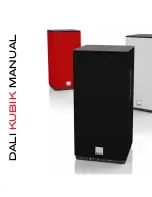
9
Owner’s Manual
Owner’
s Manual
Protection Circuits
Input Signal Wiring
We recommend using high-quality, shielded cables
to connect the signal source to the signal input jack
on MR studio monitors.
Three types of input connectors are provided to
interface with virtually any application you may have:
• Balanced microphone cables work well with the
XLR input.
• Balanced (TRS) / unbalanced (TS) cables work well
with the 1/4" input.
• Unbalanced phono cables work well with the RCA
input.
NOTE:
Route the cable away from AC power cords
and outlets. These are common sources for hum in an
audio signal. Wall warts and line lumps are especially
insidious hum inducers!
NOTE:
In certain home theater applications, it may
be necessary to connect the speaker outputs from a
stereo receiver to the inputs of the MR studio monitors
if the receiver doesn’t have preamp outputs or other
line-level output connections.
CAUTION:
Do not attempt to connect
a speaker output directly to the input
of the MR studio monitor! Speaker levels
are much higher than line levels and can damage
the input circuitry in the MR studio monitors.
However, it is possible to insert a speaker-level
to line-level signal attenuator between the receiver’s
speaker output and the MR studio monitor’s input.
Any local authorized dealer should be able to assist,
or you can build your own.
Care and Cleaning
MR Reference Studio Monitors will provide many
years of reliable service if you follow these guidelines.
• Avoid exposing the monitors to moisture.
• Avoid exposure to extreme cold (below freezing
temperatures).
• Use a dry cloth to clean the cabinets. Only do this when
the power is turned off.
There are several protection mechanisms designed
into the MR studio monitors to safeguard the
speakers and amplifiers from inadvertent damage.
CAUTION:
The protection circuits
are designed to prevent damage to the
speakers under reasonable and sensible
conditions. Should you choose to ignore the warning
signs (i.e., excessive distortion), you can still damage
the speakers in the MR studio monitors by overdriving
them. Such damage is beyond the scope of the warranty.
Overexcursion Protection
A 12 dB/octave high-pass filter below port tuning
just prior to the low-frequency amplifier prevents
very low frequencies from being amplified. Excessive
low-frequency energy below the usable frequency range
can damage the woofer by causing it to “bottom out,”
also known as overexcursion, which is equivalent
to a mechanical form of clipping.
Thermal Protection
All amplifiers produce heat. The MR studio
monitors are designed to be efficient both electrically
and thermally.
• If for some reason the heatsink gets too hot,
a thermal switch activates and turns off the amplifier.
This protection operates independently for the
low-frequency and high-frequency amplifiers.
Therefore, it is possible for only the low frequency or
high frequency amplifier to shut down while the other
remains on.
• When the heatsink cools down to a safe temperature,
the thermal switch resets and normal operation
resumes.
• If the heatsink temperature again gets too hot, the
shutdown process repeats. Should this happen, make
sure that airflow to the rear of the cabinet is not
restricted.
Integrated Magnetic Shielding
The MR studio monitors contain drivers with large
magnetic structures. The drivers’ magnets are
not shielded. Unshielded speakers can cause distortion
in both the shape and color of the picture if placed
too close to a CRT (cathode ray tube). If you have a
particularly sensitive computer monitor or TV screen,
it may be necessary to move the speakers a few inches
away.
Содержание MR524
Страница 1: ...OWNER S MANUAL Powered Studio Monitors...


































